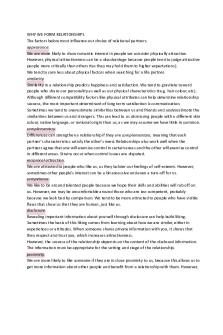COMN 1210 - Interpersonal Communication PDF

| Title | COMN 1210 - Interpersonal Communication |
|---|---|
| Course | Foundations Of Communication Studies |
| Institution | University of Denver |
| Pages | 3 |
| File Size | 81.3 KB |
| File Type | |
| Total Downloads | 65 |
| Total Views | 175 |
Summary
Notes from Dr. Preston's video...
Description
Interpersonal Communication Interpersonal communication ● involves interaction between people who are part of a close and irreplaceable relationship in which they treat each other as unique individuals ○ This is personal, whereas Dyadic Communication doesn’t have that level of a personal or interpersonal relationship commitment Relational Messages ● All verbal statements contain two dimensions: content and relational ○ Content - focuses on the subject being discussed ○ Relational - makes a statement about how the people feel toward one another (implied undertone) ● Affinity = degree of liking ● Respect = level of admiration for, does not require liking ● Immediacy = how close you feel to another person, engagement and interest ● Control = the distribution of control in the relationship, balancing act Communication Climate ● The emotional tone of a relationship, determined by the degree to which people see themselves as valued and liked in the relationship. . . verbal and nonverbal ● Disconfirming Messages - deny the value of other people ○ People in satisfying relationships report an average ratio of 5 confirming messages for every 1 disconfirming message ○ Ex: Disagreements can vary in level ○ Ex: Personal attacks can be really damaging ■ You vs I language ○ Ex: Being ignored is the most disconfirming ■ “You’re not even worth my time and attention” ● Confirming Messages - show people they are valued ○ Show recognition ■ Ex: waving to friends on campus, texting back ○ Acknowledge thoughts and feelings ■ Ex: Listening ○ Show you agree ■ Ex: Endorsement is the strongest kind of confirming message, vouch for you, or in sync with you Relational Spirals ● Relational Spirals - self-perpetuating cycle of reciprocal communication that can develop in interpersonal relationships (friends, family, partners, etc.)
● Negative Spirals - escalatory conflict spirals can get worse and worse leading to argument and avoidance spirals lead to withdrawal ● Positive Spirals - positive reinforcement of confirming messages ● We can change from positive to negative, and negative to positive talking about it and sometimes just without even mentioning it, the important thing here is to outweigh the negative momentum as much as possible Metacommunication ● Messages that refer to other messages, both verbal and nonverbal ○ Characteristics of metacommunication: ■ Often below the surface ■ Can be used for more than problem solving ■ Can be risky ○ Examples ■ An argument on the surface about playing video games vs. watching movies ■ “I appreciate you so much for listening to me” ■ I didn’t “say” anything ■ Recognizing a “look” Self Disclosure - The Onion Theory ● Self disclosure = the process of deliberately revealing significant information that would not normally be known by others ○ Social Penetration Model AKA The Onion Theory of Communication ■ Breadth = the range of subjects being discussed ■ Depth = how in-depth and personal the information is ● Achieving the right balance ○ Pick up on cues and feedback ○ Norm of reciprocity Communicating Online ● Arguably Rewarding Aspects 1. Helps people stay connected 2. Can feel nonthreatening 3. Can be validating 4. Has a “pause” option, sometimes ● Arguably Draining Aspects 1. Can be distracting a. Phubbing = ignoring people face-to-face by using your phone (phone snubbing)
2. Can be overwhelming Love Languages ● Words of affirmation ● Quality time ● Acts of service ● Receiving gifts ● Physical touch...
Similar Free PDFs

Interpersonal Communication
- 2 Pages
Popular Institutions
- Tinajero National High School - Annex
- Politeknik Caltex Riau
- Yokohama City University
- SGT University
- University of Al-Qadisiyah
- Divine Word College of Vigan
- Techniek College Rotterdam
- Universidade de Santiago
- Universiti Teknologi MARA Cawangan Johor Kampus Pasir Gudang
- Poltekkes Kemenkes Yogyakarta
- Baguio City National High School
- Colegio san marcos
- preparatoria uno
- Centro de Bachillerato Tecnológico Industrial y de Servicios No. 107
- Dalian Maritime University
- Quang Trung Secondary School
- Colegio Tecnológico en Informática
- Corporación Regional de Educación Superior
- Grupo CEDVA
- Dar Al Uloom University
- Centro de Estudios Preuniversitarios de la Universidad Nacional de Ingeniería
- 上智大学
- Aakash International School, Nuna Majara
- San Felipe Neri Catholic School
- Kang Chiao International School - New Taipei City
- Misamis Occidental National High School
- Institución Educativa Escuela Normal Juan Ladrilleros
- Kolehiyo ng Pantukan
- Batanes State College
- Instituto Continental
- Sekolah Menengah Kejuruan Kesehatan Kaltara (Tarakan)
- Colegio de La Inmaculada Concepcion - Cebu














